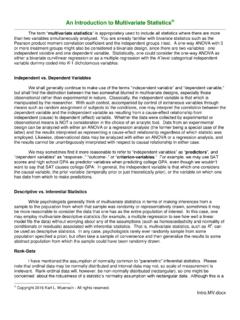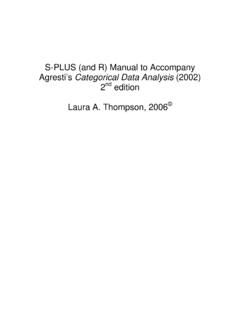Transcription of Introduction to the National Pretreatment Program - US EPA
1 Disclaimer Introduction to the National Pretreatment Program DISCLAIMER The discussion in this document is intended solely as a summary of existing guidance. This document is not a regulation, nor does it substitute for any requirements under the Clean Water Act (CWA) or Environmental Protection Agency s (EPA s) regulations. Thus, it does not impose legally binding requirements on EPA, states, municipalities, or the regulated community. The general descriptions provided in this document might not apply to a particular situation based on the circumstances. This document does not confer legal rights or impose legal obligations on any member of the public. Among other things, the document describes existing requirements with respect to industrial dischargers and publicly owned treatment works (POTWs) under the CWA and its implementing regulations at Title 40 of the Code of Federal Regulations, Parts 122, 123, 124, and 403 and chapter I, subchapter N.
2 Although EPA has made every effort to ensure the accuracy of the discussion in this document, a discharger s obligations are determined, in the case of directly discharging POTWs, by the terms of its National Pollutant Discharge Elimination System permit and EPA s regulations or, in the case of indirect dischargers, by permits or equivalent control mechanisms issued to POTW industrial users or by regulatory requirements. Nothing in this document changes any statutory or regulatory requirement. If a conflict arises between this document s content and any permit or regulation, the permit or regulation would be controlling. EPA and local decision makers retain the discretion to adopt approaches on a case-by-case basis that differ from those described in this document where appropriate and authorized by EPA regulations, state law, or local ordinances. Mention of trade names or commercial products does not constitute endorsement or recommendation for their use.
3 This document is current as of March 2011. EPA may decide to revise this document without public notice to reflect changes in the Agency s approach to implementing Pretreatment standards or to clarify and update text. To determine whether EPA has revised or supplemented the information in this document, access the document at Contents CONTENTS CHAPTER 1. POTWs and the Need for the Pretreatment 1-1 Sewage Treatment .. 1-1 Need for the Pretreatment 1-2 CHAPTER 2. Overview of the National Pretreatment Program .. 2-1 The Clean Water Act .. 2-1 The General Pretreatment Regulations ..2-2 POTW Pretreatment programs .. 2-5 Attachment 2-1: State and Territory Program Authorization 2-8 CHAPTER 3. Pretreatment Standards .. 3-1 Prohibited Discharge Standards .. 3-2 Effluent Guidelines and Categorical Pretreatment Standards Development .. 3-2 Local Limits .. 3-6 Summary of Standards .. 3-8 Attachment 3-1: Summary of Categorical 3-9 CHAPTER 4.
4 POTW Pretreatment Program 4-1 Legal Authority .. 4-1 Industrial Waste Surveys .. 4-2 IU Permits/Control 4-3 Inspections .. 4-5 Sampling .. 4-7 Control Authority Enforcement .. 4-9 Program Management and Record Keeping ..4-12 Public 4-13 POTW Reporting .. 4-14 Approval Authority Enforcement .. 4-15 CHAPTER 5. Industrial User Pretreatment Program Responsibilities .. 5-1 Reporting Requirements .. 5-1 Categorical Industrial User Reporting Requirements .. 5-2 Significant Industrial User Reporting 5-5 Signatory and Certification Requirements [40 CFR (l)] .. 5-7 Cross-Media Electronic Reporting [40 CFR Part 3].. 5-7 Self-Monitoring 5-8 Notification Requirements .. 5-10 Notification of Production Level Change in the Equivalent Limit Calculation [40 CFR (c)(9)].. 5-10 Notification of Material/Significant Change in the Alternative Limit Calculation [40 CFR (e)] .. 5-10 Notification of Waived Pollutant Present [40 CFR (e)(2)(vi)].
5 5-11 Notification of Middle-Tier Categorical Industrial User 40 CFR (e)(3)(iv)].. 5-11 Notification of Potential Problems Including Slug Loading [40 CFR (f)].. 5-11 Noncompliance Notification and Repeat Sampling Report [40 CFR (g)(2)].. 5-11 Notification of Changed Discharge [40 CFR (j) and 40 CFR (b)] .. 5-11 Notification of Discharge of Hazardous Wastes [40 CFR (p)] .. 5-11 Notification of Upset [40 CFR ] .. 5-12 Introduction to the National Pretreatment Program i Contents ii Introduction to the National Pretreatment Program Notification of Bypass [40 CFR ] ..5-12 Record-Keeping 5-12 Attachment 5-1: Summary of Reporting and Notification Requirements for All IUs .. 5-13 Attachment 5-2: Summary of Notification and Citation Requirements That Might Not Apply to All 5-15 CHAPTER 6. Hauled Wastes .. 6-1 Nature of Hauled Wastes .. 6-1 Control programs .. 6-2 Concerns .. 6-3 CHAPTER 7. Pollution 7-1 P2 and the Pretreatment Program .
6 7-3 Key Elements of a Successful POTW P2 7-4 Benefits of P2 for POTWs .. 7-4 Benefits of P2 for IUs .. 7-5 Water Conservation as P2 .. 7-6 Potential Impediments to P2 .. 7-7 P2 7-8 Preface Introduction to the National Pretreatment Program iii PREFACE The industrialization of the United States brought with it a level of pollution never before seen in the country. By the 1960s scenes of dying fish and burning rivers were repeated regularly on the evening news. In response to such critical environmental problems, in December 1970 the President of the United States created the Environmental Protection Agency (EPA) by executive order. In 1972 Congress passed the Federal Water Pollution Control Act, also know as the Clean Water Act (CWA), to restore and maintain the integrity of the nation s waters. The goals of the CWA are to eliminate the Introduction of pollutants into the nation s navigable waters and to achieve fishable and swimmable water quality levels.
7 The CWA s National Pollutant Discharge Elimination System (NPDES) Permit Program represents one of the key components established to accomplish the goals of the CWA. The NPDES Permit Program generally requires that point source discharges of pollutants to waters of the United States, , direct dischargers, obtain an NPDES The CWA also established substantial penalty authority for noncompliance with NPDES permits. In addition to addressing these direct discharges, the CWA also established a regulatory Program to address indirect discharges from industries to publicly owned treatment works (POTWs) through the National Pretreatment Program , a component of the NPDES Permit Program . The National Pretreatment Program requires industrial and commercial dischargers, called industrial users (IUs), to obtain permits or other control mechanisms to discharge wastewater to the POTW. Such a permit may specify the effluent quality that necessitates that an IU pretreat or otherwise control pollutants in its wastewater before discharging it to a POTW.
8 Certain industrial discharge practices can interfere with the operation of POTWs, leading to the discharge of untreated or inadequately treated wastewater into rivers, lakes, and other waters of the United States. A discharge that causes interference inhibits or disrupts the POTW, its treatment processes or operations, or its sludge processes, use, or disposal and therefore causes a violation of any requirement of the POTW's NPDES permit. Some pollutants are not amenable to biological wastewater treatment at POTWs and can pass through the treatment plant untreated. This pass through of pollutants affects the receiving water and might cause fish kills or other deleterious effects. Even when a POTW has the capability to remove toxic pollutants from wastewater, the pollutants can end up in the POTW s sewage sludge, which might then be processed into a fertilizer or soil conditioner that is land-applied to food crops, parks, or golf courses or elsewhere.
9 The General Pretreatment Regulations of the National Pretreatment Program require all large POTWs (those designed to treat flows of more than 5 million gallons per day) and smaller POTWs (that accept wastewater from IUs that could affect the treatment plant or its discharges) to establish local Pretreatment programs . These local programs must enforce all National Pretreatment standards and requirements in addition to any more stringent local requirements necessary to protect site-specific conditions at the POTW. Approximately 1,600 POTWs have developed and are implementing local Pretreatment programs designed to control discharges from approximately 23,000 significant IUs. Since the promulgation of the General Pretreatment Regulations in1983, the National Pretreatment Program has made great strides in reducing the Introduction of toxic pollutants to sewer systems and to waters of the United States. In the eyes of many, the National Pretreatment Program implemented as a partnership between EPA, states, and POTWs is a notable success among efforts to 1 Some point sources, however, are not required to obtain NPDES permits; see Title 40 of the Code of Federal Regulations (CFR), section , Exclusions.
10 Preface iv Introduction to the National Pretreatment Program reduce the effects of pollution on human health and the environment. Such strides can be attributed to the efforts of many federal, state, local, and industrial representatives who have been involved with developing and implementing the various aspects of the National Pretreatment Program . EPA has supported the National Pretreatment Program by developing numerous guidance manuals. In fact, it has released more than 40 manuals providing guidance to EPA, states, POTWs, and industry on various National Pretreatment Program requirements and policy determinations. Through such guidance, the National Pretreatment Program has maintained National consistency in interpreting the regulations. Nonetheless, turnover in National Pretreatment Program staff has diluted historical knowledge, and new staff and other interested parties might be unfamiliar with existing guidance materials.



















